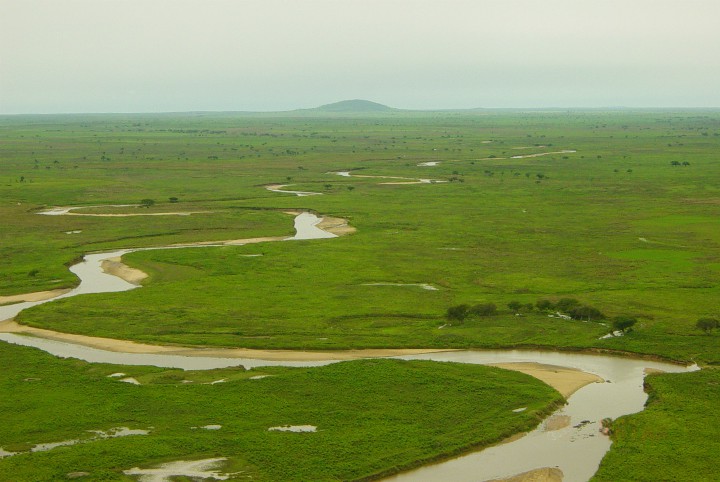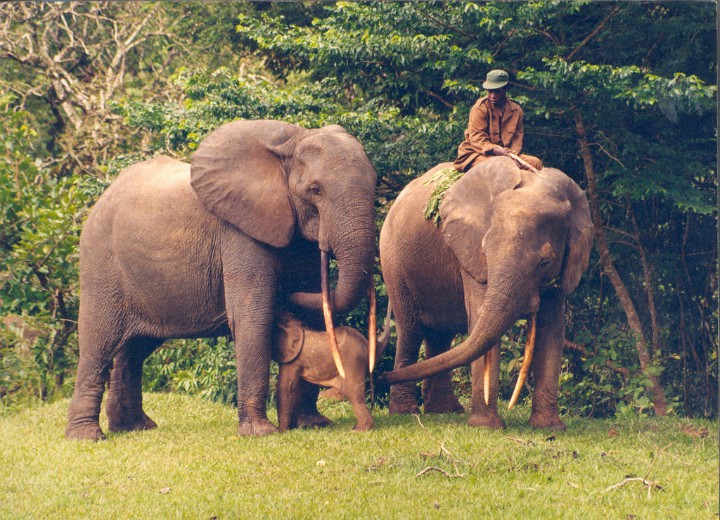Kes Hillman Smith spent 22 years in Garamba National Park in the Democratic Republic of Congo, working as a conservationist at the same time as raising a family. She talks to Tamara Britten about the extraordinary challenges of protecting wildlife in a country riven by conflict and competing interests.

What took you to Garamba?
I was working with Iain Douglas-Hamilton of Save the Elephants on the first Africa-wide survey of the status of elephants and plan for their conservation, when the then New York Zoological Society (now WCS) asked me to do a similar survey and conservation plan for rhinos. In the 1970s and 1980s, poaching was heavy; our results showed that the populations of Northern White Rhinos had not only plummeted to seriously low numbers, but that they existed in little-known ecosystems with almost no protection, namely a few parts of southern Sudan and Garamba National Park in what was then Zaire.
In 1983, with Fraser, my future husband, I did reconnaissance for the rhinos in Sudan and an aerial survey of Garamba – highly challenging in such remote regions. When war in Sudan re-started after a lull, the focus shifted to developing a project for Garamba. The Zaire Wildlife Division asked if I would come to Garamba and set up monitoring and research there, while continuing to raise support. I said: “Maybe for a year.” That was the start of my 22 years in Garamba.
Tell me about the early days of the project.
Fraser and I drove to Garamba with our dogs – mine was eaten shortly afterwards by a crocodile and Fraser’s died of a twisted gut. We built a mud hut with a thatched roof a couple of kilometres along the river from the headquarters in the Reserves. We were married at the Hippo Pools of the Dungu River and when our first child, Chyulu, was born in 1985, we were still living in the mud hut. When we started, there were no vehicles and no roads, and in the wet season the grass was two metres high. It was great in the early days. We were so isolated, we had the whole place to ourselves. It was hard work but we loved it.

And later?
Fraser’s work concerned the practical: infrastructure, roads, river crossings, patrol posts, radio systems, vehicles and airstrips, and he worked in partnership with the chief park warden to run anti-poaching. My job was to provide information for conservation and management, to establish and train a Research and Monitoring Unit, to write reports and to raise funding. The project produced one of the longest standardised aerial survey data sets on wildlife, rhinos, poaching, anti-poaching, and habitat change. There were 15 Northern White Rhinos when we came, but by 1995 there were 32. The population of elephants – which had dropped from over 20,000 in 1976 to about 5,000 in 1984 – also doubled, rising to over 11,000 by 1995. Poaching continued to be a problem. Many of the poachers came from Sudan, armed by the ongoing civil war there, and profiting commercially. We set up law enforcement monitoring to guide the anti-poaching teams. Maps and graphs monitored trends for longterm planning and helped raise support for the tough work of protection. Armed contacts flared frequently.
There was no national development in this part of the country. Missionaries had set up what were effectively banks and post offices, as well as a hospital. Aircraft were a vital tool: Garamba had a Cessna 206 and we had a Piper PA12.
Tell me about the domesticated elephants.
In an extraordinary echo of Belgium’s colonisation of the Congo, Garamba had a few domesticated elephants: the only ones in Africa. During the time of Leopold II, there had been over 50 trained African elephants doing logging, agriculture and transport like Asian elephants; four of these remained. We trained more young elephants and did elephant-back safaris. It was a way of making the place special, and funding its conservation: where else could you ride elephants to see Northern White Rhinos? The idea was to develop a tourism circuit: Garamba with domesticated elephants and Northern White Rhinos; Epulu, in the Ituri Forest, with okapis and Mbuti pygmies; and Virunga with gorillas. It would have been a wonderful circuit. But then war broke out.
How did the war change things?
In late 1996, Laurent Kabila, with the support of Rwanda, led his troops, the Alliance des Forces Démocratiques pour la Libération du Congo-Zaïre (AFDL), into the country to challenge the one-party state of Mobutu Sese Seko. The missionaries evacuated, and by the end of that year we were hiding things in our house and prioritising what to take with us: kids, computers, photographs. We were planning to spend Christmas in Kenya anyway, so we flew out in December. When Fraser returned in January, he found mercenaries working for Mobutu had taken over the park headquarters. Their leader, now living in our house, said: “Take your stuff and go. I’ve been promised Garamba as my hunting grounds.”
When Kabila’s AFDL reached Garamba, they occupied the station, seized the vehicles and looted everything. This stopped all antipoaching patrols for three months and it took careful negotiation to re-establish them. By April, the AFDL reached Kinshasa, where they established a new government and renamed Zaire as the Democratic Republic of Congo.
I was later part of a high-level mission to see Kabila [who] agreed to our request for clearance for a training support unit.
Meanwhile, materials we’d bought in from South Africa to re-equip park rangers had been blocked from overland transport and were stuck in Nairobi. A Russian Antonov crew agreed to fly it in cheaply, as long as I went with them to be in radio contact with Fraser, who was monitoring the state of the runway for such a large plane. They spoke almost no English and had only a book of Shakespearean sayings. The plane landed safely, but – in a bizarre postscript to the journey – we had to use the domesticated elephants to carry people and equipment because all the vehicles had been looted.
Then the project started again?
Yes – until August 1998, when the second war kicked off. Kabila tried to remove his former allies, the AFDL, who then rebelled. National radio was broadcasting orders to kill all Rwandan Tutsis in the country.
Fraser flew to Ituri to rescue Rosmarie and Karl Ruf, who were running the Okapi Conservation Project. When Fraser and the Rufs landed, he told me some shocking news. The day before, the military had arrested Ali, the ranger in charge of Garamba’s domestic elephants and a key link in the negotiations with the AFDL to reinstate anti-poaching after their first invasion because, although he was Congolese, his background was Tutsi. That morning, he’d been executed. That changed everything: we took off for Nairobi.
Even in war, did you still worry about the park?
Especially during a war. That’s when the animals suffer most. All of us from the five World Heritage Sites in DRC were keen to keep our conservation work going. We developed a proposal, with both [the DRC wildlife authorities] and NGOs, for the UN Foundation; I became its coordinator. This was the first-ever project aimed at continuing conservation during armed conflict. And it worked. We minimised losses, successfully maintaining the animal populations through the war, upgraded training and, under the UNESCO umbrella, were able to unite authorities responsible for the environment in each of the three occupied parts of the country.
It sounds like an incredible success story.
It was a success during the war. But the aftermath of a war is often messier than during it; attitudes change and every man becomes a petty warlord. When there was a ceasefire in Sudan in 2004, and the Sudanese People’s Liberation Army were no longer holding the border, Janjaweed horsemen came in from Darfur, massacring elephants and rhinos. We held an emergency meeting and [decided to] move some of the Northern White Rhinos temporarily to safety; we settled on Ol Pejeta Conservancy in Kenya. The president agreed, but others blocked the proposal and the agreement collapsed. The long-term conservation of Garamba was compromised by internal strife and post-war attitudes. The donors withheld support and were finally forced to pull out.
At this stage, we handed Garamba over to African Parks. They have a business approach to conservation, and plenty of financial support, aircraft, helicopters and currently extremely good people. They continue to have problems with the Lord’s Resistance Army of Uganda and the Janjaweed of Sudan, but it’s good that they’re there.
Garamba: Conservation in Peace and War, edited by Kes Hillman Smith, chronicles decades of conservation in Garamba by those who lived and worked there. Kes will be signing the book at Authors’ Corner at Christmas fairs in Nairobi and Nanyuki.